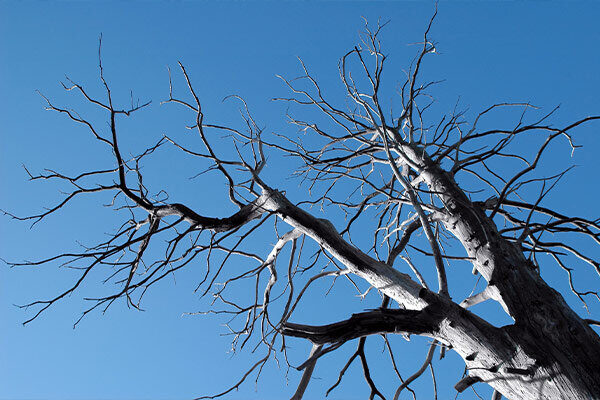Why Your Tree Branches May Be Dying
Everything seems to be going fine with your trees and you don’t notice anything going wrong, until one day you look up and your tree branches look to be dying. Sometimes, it is just one singular branch that isn’t getting leaves at a similar rate as the rest of them or maybe it is completely dead. You might notice that a cluster of branches are dying while the rest of the tree thrives. At worst, you may notice that all of your branches on your tree are failing to thrive.
No matter how many of your branches are dying, you should be somewhat alarmed when you see this. Instead of ignoring it, you may want to find the root cause of the problem before whatever it is causes the rest of the tree to die as well. Think of this as a wake-up call for you to get the help that you need. Here are a few things that your tree could be trying to tell you.
Your Tree Could Be Self Thinning
- Can be a natural part of life for the tree
- May be caused by a disease or infestation
- Tree can be trying to heal itself
Trees will sometimes self thin, meaning they will kill off some leaves, shoots, or branches to improve their own health. Think of it as a haircut for the tree itself – it is just getting rid of the split ends so that the rest of the tree can be healthy. Often, you won’t even notice that a tree is doing this – they tend to take care of things before they even appear.
However, sometimes trees will self thin when they are stressed and there aren’t enough resources to go around. It could be that the tree isn’t getting enough sunlight due to thickness, so it will thin itself out for that reason. Other times, it won’t get enough water so it self thins to preserve the healthiest branches.
In other cases, a fungus or disease can cause a tree to self thin, according to Science Direct. This can be done to help prevent the spread of the disease or infestation.
Early Leaf Shed Could Be Setting In
- Sometimes trees get confused about the season
- Extremely warm or wet weather tends to bring on leaf shed
- May also be a sign of trouble by itself
According to NC Cooperative Extension, “Trees drop their leaves early for a variety of reasons. Leaves that have been infested with insects or diseases will, often, drop early. The maple in my yard has disease tar spot, which is causing the leaves to drop now. Pests like scales, mites and white flies can also cause early defoliation. Spraying a pesticide will eliminate the infestation, but may not be practical for large trees.”
This is particularly true when you plant trees in your yard that do not belong in a specific area. For example, this is when you plant a tree that may be suited for our climate, but isn’t necessarily native here. To prevent this problem from happening to your trees, you have to be careful to plant trees that are suited for your yard, of course. However, you also have to be careful about planting trees in the right place in your yard, giving it proper resources, and even putting trees near other plant life that works well with the tree.
An Infestation Has Taken Its Life
- Sometimes infestations will stick to one branch
- Could be a sign that the infestation has spread
- Not all branches will die – don’t assume the infestation is gone
There are so many different infestations that can take over your trees, including ones that will kill it bit by bit until the entire tree dies. If your tree has an infestation, disease, or fungus, it will start to show you signs in different ways. If your branches have died, the problem has already progressed somewhat far. A branch dying is typically in the middle of the death process and sometimes, there is no going back for the rest of the tree.
If you see a dead branch and think that it is a sign of an infestation, you need to get professional help as soon as possible. Often, this is the work of a borer, according to The University of Kentucky. These are some of the worst types of infestations, so if you think you have a borer problem, you absolutely need to contact a tree care professional. There are problems all over the United States with infestations, so the more records we can create, the better it will be.
There’s A Fungus Among Us
- Some trees are susceptible to different fungus types
- May be solved simply by removing the branch
- Even dead branches can spread the fungus
As mentioned, having a fungus is one of the most common reasons why branches die. If you see mushrooms, spores, or anything that just doesn’t look like it should be a part of a tree, you probably have a fungus. They are far more common than people think – but not all of them are dangerous. A fungus is different than an infestation because a fungus may look like it has gone away, but it could still linger. It is important to gather information about the fungus before looking for solutions.
Some things to note, according to Earth.com, “In order to identify a tree fungus, the main thing to look for is the general shape and texture. The part you see is actually the fruiting body of a fungus, and it’s just the tip of the iceberg. The rest of the organism is the hidden mycelium which the fungus uses to retrieve nutrients, like the roots of a plant. The most important part of a fungus in order to identify it, however, is the visible part.”
If you believe that you have a problem with your trees or in your yard, give us a call today at (269) 216-6811 and we can set up a time to visit you and your beautiful trees to see just what the problem is – and how we can help you. There is no job too big or too small – contact our professionals today!
Remember that planting trees is a delicate art and requires a practiced hand, as does caring for those trees. If you need help, always reach out to a professional.


